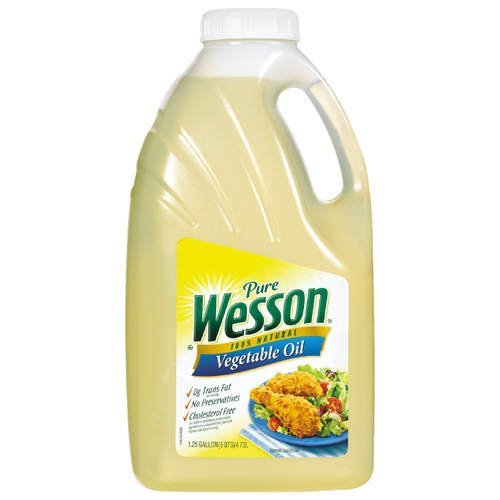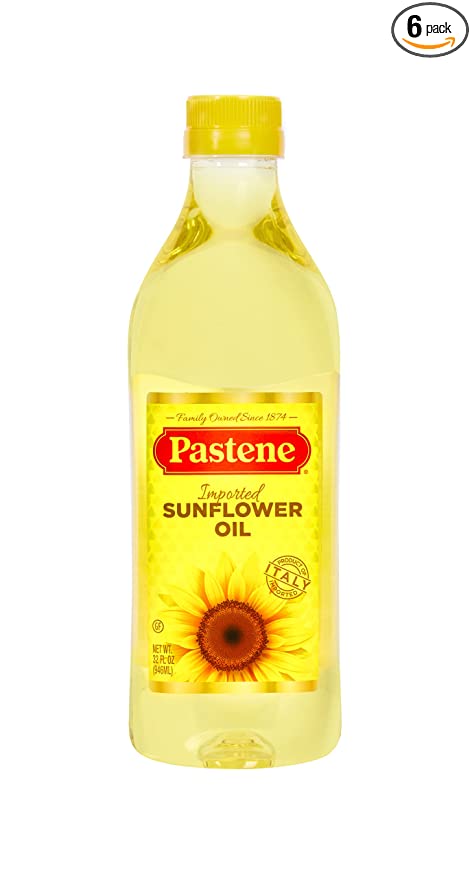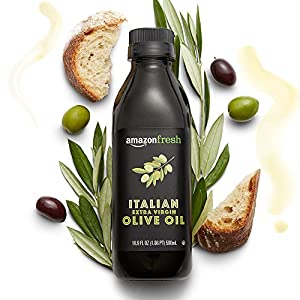Before deep-frying your homemade potato chips and crisps, you must choose the ideal oil. Here is a brief overview; for more information on the health benefits and flavors of the oils, we advise additional investigation.
One of the best oils for fries and recipes for fat-free potato chips is canola oil. When it comes to frying, it works fairly well. The conventional oil of preference for makers of potato chips and crisps is vegetable oil. Well, that is, until people started to become a little more health-conscious. Typically, it is a mixture of soy, corn, sunflower, and palm oil, though you can also obtain a single blend.
Best Oil for Cooking Chips
Vegetable Oil
Manufacturers of potato chips and crisps typically use vegetable oil. Well, that is, until people started becoming more health-conscious. Typically, it is a mixture of soy, corn, sunflower, and palm oil, though you can also obtain a single blend. It is the least expensive, which might be why it was used so frequently.
Sunflower Oil
Some manufacturers are switching from vegetable oil to sunflower oil as others abandon it. The argument is that they will utilize it for the additional benefits of this well-known antioxidant because it is high in vitamin E. The idea that vitamin E qualities are destroyed by high temperatures disputes this.
Olive Oil
An organic oil made from pressing olives. Mono- and polyunsaturated fats are found in olive oil, which is also thought to help lower cholesterol. It contains 9% polyunsaturated, 72% monounsaturated, and 14% saturated fat. From the Mediterranean region, it has expanded worldwide and is now the preferred cooking oil for various meals. It gives the potato chips a thick, crunchy texture.
Corn Oil
Corn oil, also known as maize oil, is made from the corn germ and contains 13 percent saturated fat, 24 percent monounsaturated fat, and 59% polyunsaturated fat. Due to its lower cost and higher smoke point than vegetable oil, corn oil is becoming a popular choice for frying potato chips.
Canola Oil
The rapeseed oil extract is used to make canola oil. Canadian Oil, Low Acid is the abbreviation for the oil, which was further developed in the 1970s to eliminate the bitter rapeseed flavor. Rapeseed oil is being produced in the UK at the highest level to compete with olive oil as a different “healthy oil.” Many recipes that advertise being “Fat-Free” use canola oil. It has 7% saturated fat instead of 14% in olive oil or 51% in butter. Omega-3 and Omega-6 levels are also elevated.
Peanut Oil
Another monounsaturated lipid imparts a unique nutty flavor to potato chips and crisps. Although not for everyone, it is a worthwhile experiment. It is a milder-flavored vegetable oil that is made from, uh, peanuts. It is also known as groundnut oil. It is oil because it contains a lot of monounsaturated fat.
Why Smoke Point Matter While Cooking Chips?
How oil will behave when heated is among the most crucial factors to consider when choosing the ideal oil for frying. When deep-frying, a cooking temperature greater than 212 degrees Fahrenheit is used (the temperature of boiling water). The temperature at which cooking oil can be heated to get that tasty, crispy browning result is substantially higher.
The “smoke point” is the temperature at which a specific oil begins to burn and oxidize. Cooking oil degrades when heated above its smoke point, producing toxic vapors and dangerous free radicals. A research article published in May 2018 in ACTA Scientific Nutritional Health cautions that some of these byproducts may harm health.
Using oil with a high smoke point while deep frying is critical. The Canola Council states that frying must keep the oil between 365 and 375 degrees Fahrenheit.
It is advisable to heat the oil to a temperature about 15 F higher than the ideal deep-frying temperature because adding food to the oil will cause the temperature to drop initially. As a result, you ought to select oils with a 400 F or higher smoke point. The healthiest oils for pan-frying or low-temperature cooking might be those with lower smoke points because they can potentially handle lower heat levels.
According to a May 2015 study published in Advances in Nutrition, cooking oils high in saturated and monounsaturated fats often have the highest smoke values and are more oxidation-resistant. Conversely, because they contain short-chain fatty acids that separate when heated, those high in polyunsaturated fats break down more quickly.
What is the Difference Between Unrefined vs. Refined Oil?
Various techniques can extract oil from plants, seeds, and nuts. Pressure, such as that used in cold pressing and mechanical, thermal, or chemical techniques, can be used to achieve this.
Manufacturers refine the oil to guarantee purity and clarity, reduce rancidity for longer storage, and increase their products’ resistance to smoke. According to the American Council on Exercise, the smoking point increases with oil refinement.
However, according to PennState Extension, the refining process impacts the flavor and the quantities of polyphenols, which help shield your cells from oxidative damage. In addition to decreasing oil’s antioxidant activity and mineral content, processing can also lead to lipid breakdown. According to a March 2019 study published in PLOS One, this will ultimately impact the potential health advantages of oil.
Most oils you’ll find on grocery store shelves are refined, while several are also offered unrefined, albeit frequently at a premium. Choose high smoke point oils in their purest form wherever feasible, such as virgin, unrefined, or cold-pressed varieties.
What are the Smoke Points in Different Cooking Oil?
According to the Harvard T.H. Chan School of Public Health and the Canola Council of Canada, the following is a comparison of the smoke points of some common oils that can sustain high cooking temperatures:
Fuel Type
Fire Point
Avocado Oil (Processed)
428 F
Virgin Extra Olive Oil
331 F
Canning Oil
468 F
a High Oleic Canola
475 F
Cocoa Butter (Refined)
400 to 450 F
Virgin and Extra Virgin Coconut Oil
350 F
Corn Oil
453 F
Coconut Oil
471 F
oil from soy
453 F
High-oleic Safflower
468 F
What is the Ideal Frying Oil?
High smoke points, healthy monounsaturated fat content, and a lack of saturated fats are all characteristics of some of the greatest cooking and frying oils. These include high oleic oils from safflower, canola, corn, and olive.
The Mediterranean diet is unavoidably made up of extra virgin olive oil (EVOO), and it is less likely to oxidize at high temperatures since it is abundant in monounsaturated fats.
It can be used for frying despite having a lower smoke point than certain other oils. The study published in ACTA Scientific Nutritional Health suggests that other variables, such as oxidative stability, may also be significant in evaluating whether a substance is suitable for high-temperature cooking.
The researchers heated extra virgin olive oil to 464 F and kept it at 356 F for six hours. Comparing EVOO to other studied oils, such as virgin olive oil, canola oil, rice bran oil, grapeseed oil, coconut oil, peanut oil, sunflower oil, and avocado oil, EVOO produced reduced amounts of oxidative by-products.
It was followed by coconut oil and other virgin oils, such as avocado and high oleic acid seed oils, in terms of their fatty acid profile and antioxidant content.
Similar results are reported in a May 2017 Comprehensive Reviews in Food Science and Food Safety study: When heated, olive oil performed as well as or better than other vegetable oils, and using virgin olive oil or extra virgin olive oil (EVOO) for frying is associated with disease prevention, decreased insulin resistance, and a decreased risk of heart disease.
It’s also a good idea to use canola oil, and it is often extracted with heat and hexane solvent before being marketed as refined oil.
According to the Harvard T.H. Chan School of Public Health, there has been some worry that hexane may alter its stability, eliminate omega-3s, and even produce trans fats.
But considering the minimal amount consumed from canola oil, researchers claim there is no proof to support the claim that hexane poses any health hazards. Additionally, canola oil has relatively low levels of trans fat due to deodorizing during refinement, albeit this procedure also lowers its omega-3 content.
More monounsaturated and fewer polyunsaturated fats can be found in high-oleic canola oil.
According to the Canola Council, this makes it more stable, enabling greater heat tolerance and making it a better option for deep frying when compared to other oils heavy in polyunsaturated fats, such as corn, peanut, and safflower.
Sunflower oil is another option. Although it has a high smoke point, virgin olive oil has the opposite impact as sunflower oil when used for frying, according to a study published in the European Journal of Nutrition in June 2017.
What does Trans Fat Means?
When producers add hydrogen to vegetable oils to make them more solid, trans fats are also referred to as partially hydrogenated oils. Additionally, some dairy and meat products naturally contain trace levels of trans fats. Artificial trans fats can lower your high-density lipoprotein and raise your low-density lipoprotein, which is the “bad” kind of cholesterol.
High Monounsaturated Oil: What is it?
The term “high monounsaturated” refers to the fatty acid profile, which is the actual composition of the oil. The ratio of the three types of fat that all edible oils contain—saturated, polyunsaturated, and monounsaturated—is known as an oil’s fatty acid profile. Various oils have different fatty acid compositions. For instance, cottonseed oil has a substantially different fatty acid profile than olive oil. It is precisely Non-GMO “high monounsaturated” safflower, sunflower, canola, or olive oil that we utilize for all Kettle Brand goods.
Its naturally high monounsaturated fat content makes it far more so than the bottled safflower, canola, or sunflower oil frequently found on grocery shelves. Still, it does not specifically state that it is “high monounsaturated.”
Which is Healthier, Olive Oil or Vegetable Oil?
Here, olive oil is the undisputed champion. The benefits of olive oil over the other two oils are as follows:
Vegetable oil is not as healthy as olive oil. Why? When consumed in moderation, “healthy” fats, or monounsaturated fats, found in olive oil, may help your heart. Minerals and helpful antioxidants are also present.
Is vegetable oil still acceptable? Yes! Vegetable oil goes through a lot of processing to remove its flavor but loses all of the nutritional elements in the process. Additionally, it contains omega-6 fatty acids, which can increase inflammation. Use vegetable oil sparingly (and organic if you can find it), and stay away from hydrogenated vegetable oils.
Use olive oil as your all-purpose cooking oil because it is the healthiest option. Consuming vegetable oil moderation is possible; look for organic, non-hydrogenated vegetable oil.
Conclusion
It’s amazing how many different kinds of oil are available in supermarkets today, ranging from flavorful extra-virgin olive oil to neutral oils like canola and vegetable oil. But there’s more! Additionally, there are specialized oils like grapeseed, coconut, sunflower, and many others. Flavor and smoke points are two crucial considerations when frying using oil. Since it can cook at greater temperatures without adding too much flavor, neutral oils with high smoke points are preferable for deep frying. Check out these oils, then try frying some chips and shoestring fries on your own.








